#because nothing anyone ever said about them struck me as particularly profound or significant
Explore tagged Tumblr posts
Text
posting my response to this eah confession about dappling and the implications of destiny so i dont lose it when i want to write more later:

#ever after high#apple white#darling charming#dappling#i love dappling and comphet apple as much as anyone but this is such an interesting and fresh angle to me#i always cherished dappling like distantly because i never had anything to say about it#because nothing anyone ever said about them struck me as particularly profound or significant#but this seems important and even plausible#like obviously raven isn’t going to be much comfort because she’s not going to coddle apple#or lean at all into her old destiny and the old system just to ease apple into the new system#and apple is a person who needs to be eased into the new system#so really all apple has of the story she grew up with and has loved all her life is darling which is damaging for both of them#look on my works ye mighty and despair#og my gosh i GUESS
80 notes
·
View notes
Text
9x04: Details
Okay, let's get down to the details.
***As always, spoilers for 9x04 abound in this post. Don’t read until you’ve watched! You’ve been warned!***
Michonne:
In the opening sequence with Michonne, we saw a lot of interesting symbols. Apples (which we later also saw Daryl eating; Apple Theory), lots of books with visible titles, and we also saw Michonne journaling, which reminded me of Beth.

In the sequence where she saw the walker hanging and eventually picked up the bat, it reminded a lot of us of Sasha in S5. Michonne just seemed angry and somewhat out of control.
Negan, talking to Michonne, proclaimed himself on the C team. Kind of interesting because back in the prison, entire group stayed in the C block of the prison. Symbolically, C seems to represent wherever TF is currently living. So just more reinforcement of the ABCD symbolism.
Talking to Michonne, he tells her she’s a warrior and should embrace her violence. (Ever the manipulator.) Negan says that behind walls and bars, "we die." He means the warrior. I don’t even think this is a particularly TD theme, but we’ve seen it in the show before. Um, back in S5? Remember Carl said being in Alexandria would make them weak, and then Rick, Carol and Daryl discussed it on the porch. Just saying this is yet another theme that ties back to S5.
This isn’t anything new, but it also struck me how often Carl has been mentioned since he died. Michonne kept saying, "He’s still here," and she means that he's there in spirit, even though he's dead. Notice how they never said anything like that said about Beth. Father Gabriel asked Maggie about her in 5x10, but since then we've had exactly zilch.
Judith’s painting on the wall looked just like Eastman's daughter’s. Just pointing that out.
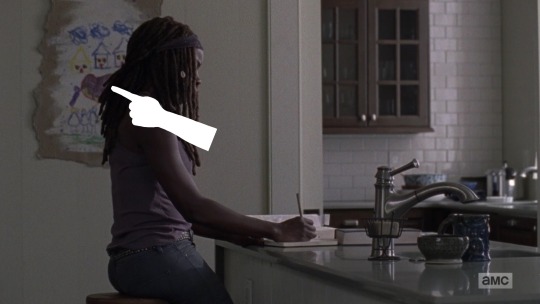
At one point, Negan tells Michonne, "we’re the same," and repeats it twice. That's exactly what Crazy Tattoo Guy at Terminus said too. So callbacks to Terminus, and the reiteration of that theme.
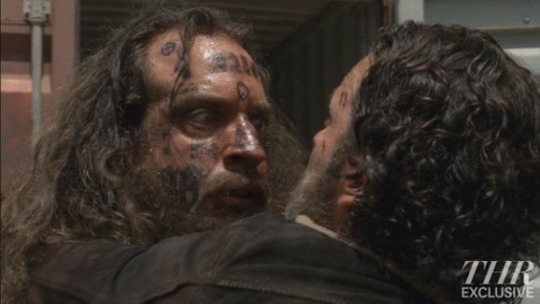
It’s an interesting theme. They’ve talked about it a lot on the show, and on TTD. Just about how there’s potential for EVERYONE to become a monster. The difference comes in individual choices. An interesting theory about this was put forth in my group, though. Since they were talking about parenting children, and Negan said he and Michonne were the same…perhaps a hint that Negan is Gracie’s father after all?
I thought it was sweet that Michonne talked about her sons (plural) and her daughter (Judith). Negan also said “nothing is worse than nothing.” (The profound themes were strong with this episode.)
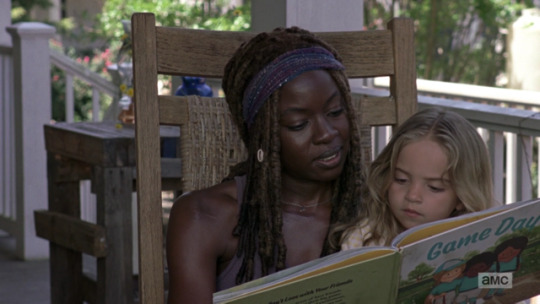
I also wondered about the Game Day book Michonne read to Judith. I noticed the part she read talked about everyone putting on their gear for the game. Might have just been a small foreshadow that shit’s about to go down, either with Rick or the Whisperers. Don’t know if it will connect to anything else. Kind of interesting, though.
Eugene:

It caught my ear that Eugene talked about how there was a big buildup of water under the bridge overnight. That was significant because it happened overnight, not over a long period of time. It reminded me of 4x01 when Carol told Daryl that there'd been a big buildup of walkers against the prison fences overnight. The dialogue is even the same. (”big buildup overnight...”)
We were right about the names of the hordes being Shakespearean! Yea!
I knew right away we were when he called the new herds Tybalt and Cordelia. Seriously, I've never heard the name Tybalt used anywhere except in conjunction with Shakespeare. But then Eugene goes on to admit that the names are coming not only from Shakespeare's characters, but specifically from deceased characters in his plays.
Carol:
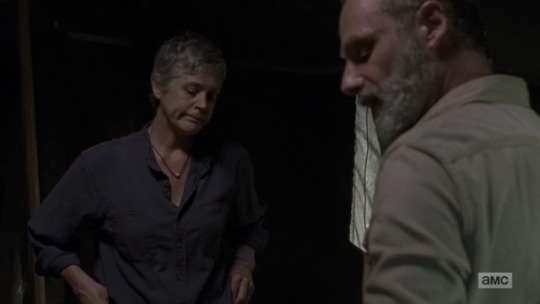
I don’t have a whole lot about Carol and Rick's interaction, except that Angela Kang did say on TTD that it's a callback to S4. Basically, it's supposed to be a mirror or an anti-mirror of the fact that Rick banished Carol in S4. Here, he talks about how he admires her, and her transformation gives him hope.
In this part, Carol says if the state saviors leave the rest of the group, that's on them. They need to “figure out who they want to be.” Major theme right there.
When Jed and the Saviors showed up to pick a fight at the bridge, Carol of course pretends to stand aside at first and then kicks his butt. He takes the keys, and the camera focused on those a lot. (Key theory.)
That's actually the last we saw of this particular plot. Rick and Daryl heard the gunshots and worried it would draw the walkers, but we don't actually know how the fight between Carol and the Saviors turned out.
Rick and Daryl falling into the hole:

Daryl says, “this time, man, it’s gonna go the way it was supposed to.” That theme was repeated constantly throughout 5x09. You know, the last episode we SAW Beth in before S9? (“It went the way it had to. The way it was always going to.”
The biggest thing this reminded me of is the Governor episodes. In 4x06, at the end of the episode, he falls into the big hole, that looks like a grave, with Megan. Walkers fall in as well and he has to fight to keep them from biting her. Walkers even fell into Rick and Daryl’s pit eventually, just like with the Gov.
The most significant thing about this, aside from all the Beth parallels in the Governor episodes, is that right after falling into a grave, the Gov is reunited with people he knew before and hadn't seen a long time (Martinez). That makes me hopeful.
We also have some serious resurrection symbolism here because we have living people trying to claw their way out of a grave.
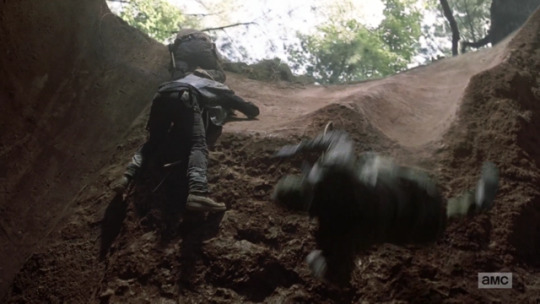
There are so many interesting things in their conversation, some of which I talked about yesterday.
Daryl also mentioned, "trying" which we know is a theme. One we specifically heard him talking about in 5x06, Consumed, when he was looking for Beth.
He also talked about having faith. He said Rick wanted them to have faith in other people, but the truth is that Rick didn't have enough faith in them. Rick denied that being true, and explained that he was trying to honor Carl. And who was the original person to lecture Daryl about faith? That would be Beth.
It was super-sweet when Daryl said he would die for Rick and would've died for Carl.
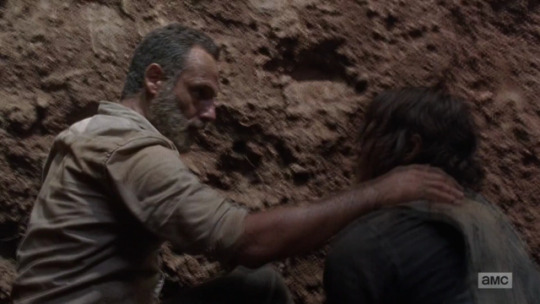
I think it's super important that Rick and Daryl had to help each other get out of the pit. There's a lot of symbolism there, and for me, it's yet another way of showing that Rick will be back. Daryl couldn't get out of the pit without Rick any more than Rick could've gotten out without Daryl. They need one another to survive and thrive, so Rick can’t be dying yet.
Everyone in my FB group immediately recognized the parallels between this scene and Daryl Rick climbing out of the ravine in S2. I’ve also seen edits of it around the fandom, so this wasn’t lost on anyone. It’s kind of an opposite situation, though.
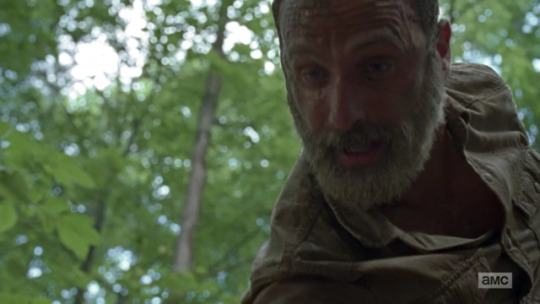
In S2, Merle wasn’t truly there. Daryl was just hallucinating him. (Which also might be a foreshadow of Rick’s coming hallucinations, btw.) Here, obviously Rick is present in the flesh. But more than that, Merle didn't actually help Daryl out of the ravine in S2. Daryl had to get himself out. Here, Rick reached down with his hand, called Daryl ‘brother,’ and helped him out.

It was even more poignant because of the parallels to Merle, imho.
They were climbing out of a grave while death tried to pull them down. We even saw the walker hands reaching up from below, which I thought was a powerful image.
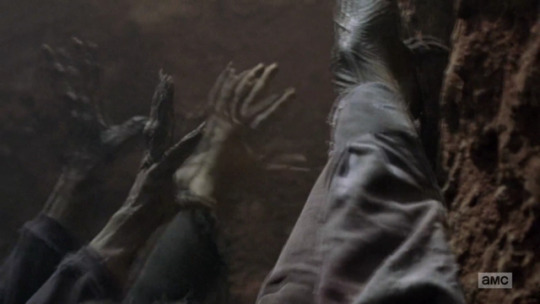
I even feel like…
…okay, maybe I’m delving WAY too deeply into this, but I was thinking that Rick and Daryl ended up in that pit because of their own stupidity. They were having a petty argument, and it came blows. Then they accidentally rolled into a RANDOM. GINORMOUS pit. I mean, who put it there? And why didn’t either of them notice it? Probably because they were too busy punching one another.
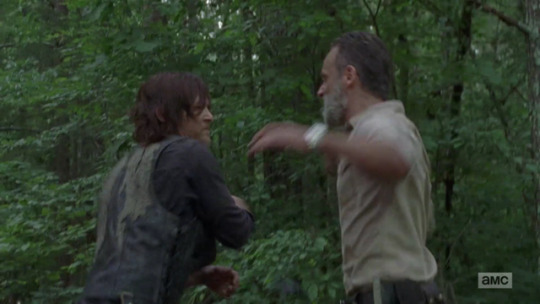
So again, I feel like they fell in because of their own foolishness, and then had to claw their way out. Sounds a lot like what happened at Grady. Beth stabbed Dawn in the shoulder. By doing something foolish, she kinda got herself “killed.” And I do believe that afterward she clawed her way back from death. AND it had something to do with a walker horde, hence the hands reaching up for Rick and Daryl. Just felt like a really sympatico parallel to me.
Two things about the very end:
1) Rick riding a white horse to go save the bridge. White horse equals Beth and the horse symbolism.

2) Rick wanted to do something very dangerous (try to lead the walker horde away from the bridge) and Daryl told him not to. Rick didn't listen, so eventually Daryl relented. This is a very close parallel what happened at Grady. Daryl didn't stop Beth from hugging Noah, and because of that she was shot. Here, Daryl didn't stop Rick from doing something dangerous, and because of it. Rick was impaled. If he loses Rick now because of that, it's going to completely devastate Daryl.
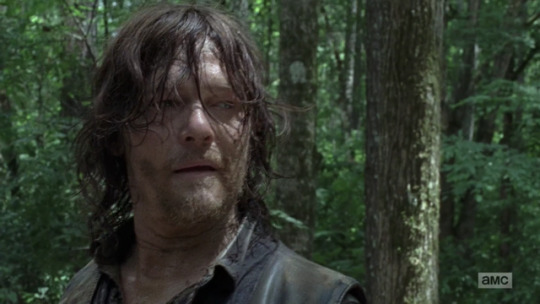
Did I say two things? I meant three! (I actually wrote the above two first and then, re-watching, realized a third.)
3) The white horse. It occurred to me that I had no idea where that white horse came from. It just showed up all of a sudden. I re-watched all the Rick and Daryl parts to figure out where the horse shows up from and finally understood that it came from the Carol/Saviors confrontation. When the guns start going off, we see it running away from the scene. It got scared and took off, ending up near Rick and Daryl. Okay, that explains where it came from. But it’s still a little convenient, no? And as far as Rick and Daryl are concerned, it basically just came out of nowhere, running out of the woods.
So my go-to response is that this must be symbolic. And we all know who the white horse represents, right? So I’d say this represents Beth suddenly appearing out of the woods…right when Rick heads off toward the walker horde.
Oh, but it gets even better than that. Also while re-watching the Rick/Daryl scenes (seriously give yourself permission to re-watch those scenes in this episode a hundred times) something else caught my eye.

Rick physically pulls Daryl up out of the pit, right? I noticed that when trying to do that, as Daryl is reaching up and they sort of miss hands several times, Rick keeps repeating, “You’re almost there. You’re almost there.
That struck me as a little odd. Not “we’re” almost there. “You’re” almost there. So think of it this way. If the pit with walkers at the bottom represent death, and Rick and Daryl getting out represents coming back to life, we have Rick saying to Daryl, “You’re almost there. You’re almost there.” We all know Daryl has emotionally been in the pit since he lost Beth in S5. The emotional pit where he believes all these negative things about letting people go and not honoring the dead.
So I feel like this is the writers telling us that symbolically, he’s finally going to make it out of the pit. And what shows up right after he does? The white horse. Randomly. From out of nowhere.

And because Rick is involved; the one who says this line, helps Daryl out and rides off on the white horse, I feel like something about Rick is what will bring Daryl out of the pit. In other words, something about what Rick is about to will lead to Beth. Which will finally pull Daryl out of his 4-season emotional funk.
Man, I hope I’m right about this. ;D
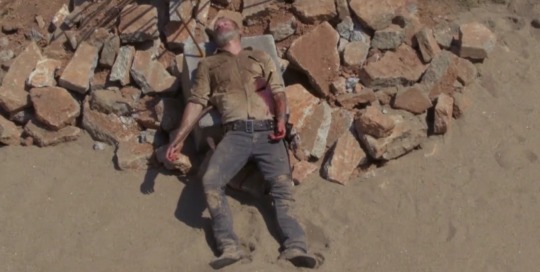
It was also pointed out in my group that Rick's wound is in the side, which actually is a mirror of one of Christ's wounds. He was stabbed in the side before dying. And that's not the first time we've seen stigmata wounds on Rick. Remember, he impaled his hand in a crucifixion sort of way when he was fighting Winslow in S7. Just more evidence that this death will be a fake out and he'll be returning.
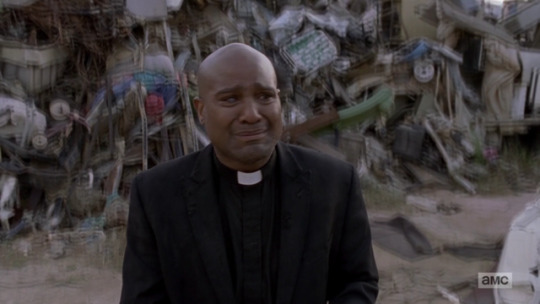
P.S. Sucks to be Father Gabriel. Poor guy.
I think that’s all I have for now. Given that today is Halloween, I can’t promise I’ll have a post for Thursday, but I do want to go over some things said on TTD. There were a lot of them this week and many of them were very important. So I’ll aim for that for Friday. Cheers!
#beth greene#beth greene lives#beth is alive#beth is coming#td theory#td theories#team delusional#team defiance#beth is almost here#bethyl
15 notes
·
View notes
Text
Fell on Black Days...
When Chris Cornell died my social media feed flooded with posts about those lamenting the loss. It reminded me of previous occasions such as the death of David Bowie, Alan Rickman, and the plethora of celebrities who passed last year; online communities posting music, gifs, memes, and video clips as a way of eulogizing the departed. Then as now I scrolled through myriad such signs of mourning wondering why these deaths mean so much.
I usually feel detached from the demise of a celebrity. Even those I admire have never really affected me in any obvious fashion. It’s hard for me to be overly distraught over the loss of a person with whom I had no interpersonal relationship. That isn’t to say I don’t have some type of personal connection, but such threads always struck me as more nebulous and abstract. For instance, throughout high school and college I listened to Pantera a great deal, however, when Dimebag Darrell was murdered I didn’t experience any profound melancholy. And yet, I know for a fact that his death still affects the mood of many Pantera fans. Simply putting any of their music on a jukebox eventually elicits the attention of a CFH enthusiast, who invariably nods somberly – funerary headbanging – as they turn the conversation, almost immediately, to the death of Dimebag: “This is a kickass song. Sucks that he’s dead, man.” Joy of the song sharply gives way to a reminder of the dead.
Now, that may seem an extreme example, a murder is bound to hold root in anyone’s mind, but the same is true for celebrities who have passed less horrifically. Dead musicians draw out the most common instance of this, really listen to the conversations people have about deceased celebrities. Talk starts out mentioning why so and so meant a great deal to an individual, but discussion soon moves towards two statements:
1. There will never be more (films, songs, paintings, etc.) from Blank. 2. What remains will often be less enjoyable; now tainted by death a song, a scene, or a photo becomes a reminder of loss.
What concerns us most is that we’ve lost those things which gave us happiness. The joy of hearing a song or seeing a film will never be quite as potent now that it serves as a reminder of loss. However, it’s never about the person, it’s about their product. To this day, people still remark on the suicide of Hunter S. Thompson in regards to wanting his writing, particularly the dagger prose with which he might stab whatever current political madness is rising. Yet, I’m willing to assume, with absolute certainty, Thompson’s son, Juan, doesn’t want his dad back so he could write another book. Fans can only want back that part of the celebrity they actually knew.
Our connection to famous people is often indirect. We assume a level of relationship potential based on how their works make us feel as opposed to any understanding of the actual individuals – just because you love Kurt Cobain’s music doesn’t mean you’d be best friends. (In fact, the more one tends to learn about beloved celebrities the less appealing they actually become. Hunter Thompson could be a wild merry prankster, or a frighteningly explosive volcano. Just ask his ex-wife. Louis Reed may play the music you love, but he never met a woman he wouldn’t brutalize. Roman Polanski: rapist. And let’s not even start down the horrifying litany of offenses numerous sports icons commit from every conceivable type of cruelty to outright murder.) Because we don’t actually know them celebrities can be the people we want most in life: someone who understands us; and a vicarious means to see our dreams come alive.
So it’s no wonder those products become tainted. Hearing a beloved song by Bowie is a constant reminder that the man who wrote it, who seemed to speak to your very soul, is gone. Watching Gentlemen Prefer Blondes, depending on your inclination – Jane Russell or Marilyn Monroe – means that vicarious sex appeal really is just a dream because the actors are dead and gone. There’s no one living it for you, and though films are always fantasy, they seem less so knowing the performers are alive somewhere in the world. In essence, what’s lost isn’t so much the celebrity, but a degree of connectivity to others as well as dreams.
Abstract though it may be art unites at a subconscious level, so do sports. At the minute details our preferences become subjective; however, broadly speaking they involve general themes. I may have turned on “Becoming” because of my own particular reasons, yet it speaks to any other Pantera fan who hears it, in essence giving us proof we aren’t alone in life. There used to be someone who created something that connected strangers to one another. It’s a profoundly unique accomplishment. So it’s no wonder the loss of that focal point leaves us adrift for a while. Such communities orbit the celebrity, and without them a real threat seems to emerge: the lynchpin is gone, so the whole cosmos may fly apart. Yet, now is the beginning of true immortality. The memory sustained by devoted fans, the legends turn into mythical gods, holding the universe together.
#
I get how material is tainted by the loss of a celebrity, but I’ve always been comforted by the fact those same materials still persist. For instance, Chris Cornell is gone. I can still listen to his music, and though it may stir some darker sentiments than before, his absence doesn’t change what it once meant to me, and will mean again. That thing which was significant to me still remains, so in a way is comforting. Still, I find it hard to cry over the loss of a man I didn’t know. Loving his music doesn’t mean loving him, and I haven’t lost his music. In fact, I haven’t lost anymore of Chris Cornell than I ever had, while his friends and family have lost an entire human being from their lives.
Others aren’t likely to be as dispassionate as I am. I’m well aware of this. As such I can’t help wondering if I’m missing out on something. While no one ever wishes to grieve it seems like those who do, in these instances, who are not his immediate friends and family, have lost something profound. It’s entirely possible I’ve missed out on a depth of feeling of some significance, and I sometimes worry if that means I lack something human not having that. Still, it may simply be that I’m more connected to the moments of my own life: at this movie I got my first kiss; this album acted like the soundtrack to that horrible winter; her book inspired me to be a writer, and his showed me the way to my voice… it probably sounds incredibly narcissistic I’m sure. Unless one considers it like this: any kind of death is mostly a reminder of our own mortality, so although there’ll be no more elegant plays, films, songs, or whatever, recognizing the loss should serve as inspiration to spend time with the real people in our lives.
Sure, let Bowie be the soundtrack to your adventure, but make sure to have one. He certainly did, and who’s to say you might do any less? Missing the words of Hunter, what’s wrong with yours? Alan Rickman can’t share that sonorous voice, so I guess it’s time you did. There’s an absence in the universe that needs to be filled, not because of some selfish desire for fame, but because maybe you can make someone feel less alone carrying the torch a celebrity dropped when they died. It doesn’t even require being a superstar.
Going back to Cornell, there’s someone out there right now who feels a bit of worry. The creeping dread flickers at the edge of their mind-sight threatening the possibility there will never be another Soundgarden, or Audioslave to sing the songs which made their life shiny on dull days, brilliant in blackest night, and endurable when torturous… yet, perhaps, it takes a simple visit to kill such bleakness.
Put on an album. Pour some drinks. Share some memories, while making some more. Because it’s never really the musician, the actors, or the athletes we’re remembering. It’s seeing that film where a first kiss happened, hearing the music that made high school bearable, the bonding chats at the ballpark… escapism in real time, flavoring the days.
The seasoning tastes a bit different, but it’s still there. That’s life.
“Someone tried to tell me something Don’t let the world bring you down Nothing will do me in before I do myself So save it for your own, and the ones you can help.”
Well said Mr. Cornell. Thanks for the tunes. They’re more precious now, though the cost is too high. Yet, unable to change reality, the only thing I can do is what I will do. Keep playing those songs so a rock legend becomes a rock god, and so, in a way, immortal.
#writing#honestyisnotcontagious#celebrities#dead celebrities#soundgarden#chris cornell#essay#nonfiction#op ed#opinion
7 notes
·
View notes
Text
ART HAS NO PURPOSE, ONLY CONSEQUENCES
An interesting sentence, uttered by a friend of mine while we were chatting over drinks, was that “Art has no purpose, only consequences.” and these six words really struck a chord with me. In today’s blunder therefore, I’d like to explore this statement, because I think a lot of us may posses a misconstrued understanding about our artistic production that could (and probably does) influence our ability to reach the right audience and consequently grow as artists.
But why does art not have any purpose? If you’re a regular of this blog, you’ve probably noticed me state several purposes pertaining to art throughout my writings and podcasts, and so the idea of art without purpose might seem a bit off.
To be honest, this fact is precisely why I had to write and explore this novel perspective, as it seems that just such a misrepresentation or miscommunication could be the culprit of a lot of convolution among us artists (not to say the art world in general)!
My personal view of life is that everything has either purpose or capability; the later being a given, as physical reality cannot be without capability (if nothing else the capability of being or existing), and purpose as the basic conception of said reality, projected upon it by beings.
An art piece, regardless of whether it is a painting, drawing, installation or any excuse for a real work of art, like the stuffed shark that made headlines decades ago, seems to posses some form of purpose. Were it not so, how could one possibly explain all the weird works that serve no utilitarian function, have no real graspable concept of what their purpose was (except maybe to be sold at outrageous prices on the secondary market)?!
And such riddles can — as with anything in our beautifully convoluted world of art — quickly be explained away by some form of concept. All we really need to understand even the most unintelligible work of art, possibly even completely void of meaning at the time of its conception, is just a glint of meaning that can be quite easily provided by just expanding ones context regarding any particular work, and eventually ending up at a feasible (albeit usually quite banal) explanation of what it should be representing.
A wonderful example for this is the function of an artwork’s title, and who better to direct our attention to as an example than the famous taxidermist of the art world himself, Damien Hirst.
Hirst’s work has always been accompanied by incredibly poetic titles and this was by far no coincidence or merely a reflection of the depths of his romantic, world-pondering soul. His decisions to name a rotting cow head with flies and an insect zapper, incapsulated inside a glass tank with the title: “A Thousand Years” was almost genius.
Maybe not in the sense of the renaissance idea of genius, and definitely not in the sense of master craftsperson, but fitting to the times, Hirst’s work was exactly on point:
Make art that creates a spectacle — preferably based on shock factor, so you can divide your audience into two disparate factions — and let people quarrel over your work until full media coverage saturation has been reached. Then repeat.
Anyone fond of Guy Debord’s book The Society of the Spectacle will quickly notice that such an approach cannot be sustained indefinitely (and alas, after Hirst’s worldwide Gagosian show and most prominently after his last Venice gig, even history itself stands as an undeniable statement of such logic).
Let’s therefore look at how and why Hirst’s career took such a turn (and why a lot of contemporary art will face the same music eventually):
Let’s start with why it failed, because his why was actually interlaced with what interests us the most — purpose. Damien Hirst’s work does not have any purpose, but what is even more problematic than that, it had no capability to ever have a purpose — at least not in the usual sense of how artworks become integrated into society.
While nothing really has purpose on its own, things achieve purpose because people project function upon them. If done individually, such a mechanism produces singular tools, like hammers, spears and axes, and if done communally (meaning by a group of likeminded people), such mechanisms create systems.
These systems are more or less just collections of particular tools and their interrelations, that, exactly because of these interrelations, produce much more complex and profound meanings and usage scenarios, than if the tools weren’t part of a singular system (think Gestalt theory) .
Simply put, the fax machine when it was invented was useless, just like the phone was useless, because such a tool’s only purpose was to connect to other similar tools. If you’re the only guy or gal with a fax machine, it just doesn’t make sense to have one. You need others to have it too, and only by a myriad of other fax machines in operation does you own fax machine become a valuable asset — the more fax machines there are, the more valuable yours is.
And it’s similar with art, too. A painting is only as valuable (in monetary and historical/cultural terms) as the amount of people that share the belief of it being valuable.
You can also think of the amusing joke that used to circulate the internet (and probably still does in some places), where a distinction between religion and clinical insanity is drawn by comparing how many other people also believe and can communicate with an imaginary man, living in the sky. If you’re the only one one, you’re most likely crazy and should be hospitalised, but if it’s thousands or even hundreds of thousands of people, well, then it’s OK, because it’s a religion.
But I don’t wish to press any buttons here, religion has its place in society (take it from a no-nonsense atheist).
But to get back to our example about Hirst; his works, while incredibly amusing, profoundly shocking in their nature and extremely well done, did lack one important part — a perpetual common ground amongst the art goers that saw them.
Without it, they would (and did) vanish into oblivion, because if a work of art does not possess the ability to latch-on to a particular aspect of its contemporary cultural context (or in hindsight the same context, but viewed in retrospect), the work cannot hope to stay significant after the initial shock has lingered and the magician turning the knobs and leavers behind the green curtain gets outed by the public.
To propose a more general example, imagine a portrait painter of the 18th century — anyone really, it doesn’t matter — because our hypothetical (or real) portraitist will be of the “crowd pleasing” verity, meaning his or her (but let’s not kid ourselves, it’s the 18th century, it’s his) art will most not be created to embody any deeper meaning or message, apart form the obvious goal of portraying his commissioners in the best manner possible.
Such works will most likely be shunned by his contemporaries and the only possibility of ever attaining significance in the grander scheme of things will be if after let’s say one hundred years or so, historians establish our crowd-pleasing artist’s era as a time of empty shenanigans and meaningless debauchery.
In the grand image created, his work might become a prominent example of his time, because the merit upon which quality has been decided has changed for the usual “how much impact does any particular thing or person have on its society” to “how much of a particular thing or person is (or was) present in society” — to say differently, quality has morphed into quantity.
And this phase of understanding Hirst’s body of work is still to come, as much more time has to pass for the collective thought to become detached from what has been in the context of what is now, to notice and propose such an understanding of art (and everything else we produce).
But the gist of the starting remark was that art has no purpose, only consequences, so let’s explore how that fits into everything we’ve talked about so far.
Art — like everything we create to be part of our society — has purpose, because everything that is observed intently by a being ultimately has some purpose.
Even if just a tiny, insignificant one, like the purpose of a pebble that was moulded by millions of years of environmental change and turmoil, only to be tossed into a lake by a child at one time in its existence.
It’s really the system in which art is exhibited that helps it attain some form of purpose; as we’ve stated, for anything to have “a purpose”, it first has to be noticed, and with an ineffable amount of things floating in the universe, noticing any particular thing is quite the statistical miracle.
Galleries (and museums) help here, because they serve as undeniable locations where art and art-like objects can be found. After any object has been placed inside a gallery or museum, it kinda becomes art — if nothing else, it gets a chance to be scrutinised by members of the inner sanctum of any particular art society (or even the whole art world if we’re talking mega-exhibitions).
The way such progressions form is by first attaining the status of “maybe it’s art”, then evolving to “yep, it’s art” and sometimes to “magnificent art”. In rare cases, a work will even become “the best of its time”!
Here’s a rough draft of how that happens:
The art-like objects can usually be found in galleries (especially lower tier ones). Because they are located inside of the gallery (sometimes they can also be found outside), they get the status of “maybe it’s art”. After the show opens, they are judged primarily by a smaller group of people, and if they pass, they are given the “yep, it’s art” stamp of approval — albeit a tiny stamp to be honest.
But the journey doesn’t just end there, now, if a person of higher status and stature finds them particularly interesting, they might get another chance at a bigger gallery and for a larger, more important crowd (usually they judge how well they can be incorporated into contemporary society in the context of not only the “now”, but also the past and sometimes even the future).
If they pass that part too, they might become “good art” or “magnificent art” and if eventually they end up in any permanent museum collections, they attain the label of “certainty” and such artistic objects usually go on to become “the best of their time”— that’s why artist’s works grow more important if they become part of any museum’s permanent collection.
But, all of this is still only talking about purpose though, there is still no sign of consequence. My personal take on why this is so, is because the consequence part is only true at the initial phase of the artistic process — when we are creating art — and we haven’t been talking about that at all.
We rarely even see that part of the artistic process, it we’re being honest! The problem is, that at the end of a long painting session or after the completion of a sculpture, the status of the finished object transforms from personal and intimate exploration of self, into a public trace of the process that has unfolded.
This of course doesn’t ring exactly true for performance art, happenings and the like, where the process of personal exploration itself becomes the literal (and ephemeral) trace — the artwork — but regardless if anything you create has a physical body in some way or another or if it’s just a fleeting moment in time, it’s all the same as far as questions of purpose and consequence are concerned.
The process of creation bears as its consequence the trace; that’s the art work. This is the intimate part of creation, the part that no-one can really explain away by saying “You did it, because of this or that.”
Its existence is not a consequence of any particular concept or desire, it is a consequence of being. This is the place where no-one can judge a good or bad expression, what matters is that whatever it is that needs to go out is actually expressed, and that it’s done so fully and without constraints.
This is the space where play happens, where we let go and enter into a state of just being.
But after playtime is over, after we regain full consciousness and contextualise ourselves again in the grander scheme of society, time and space, our creations, the traces of our free expression can become imbued with purpose, but only if we so desire. If we do, we present them to the public and insert them into the system that we call “The Art World” (though sadly it’s now more or less referred to as “The Art Market”).
If they appreciate our creation and we have the right combination of good timing and luck, our creations beget purpose, because people create it because of them and project it onto them. If not, they stay consequences, consequences of pure will, determination and the ability to let go and synchronise with the moment.
In either case, it’s always a combination of courage, skill and craft. Without courage, artisans create empty shells, without skill and craft, artists create bollocks. But in the middle, there lays the promised land of not only appreciation and monetary independence, but also of a life fully lived.
from Surviving Art https://ift.tt/2LMGyXX via IFTTT
0 notes